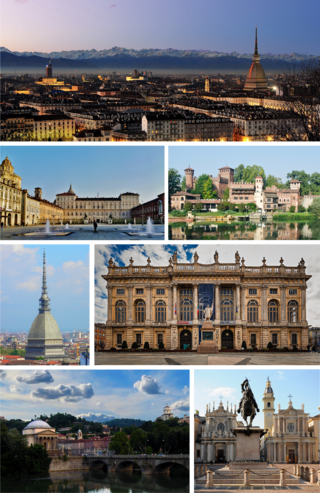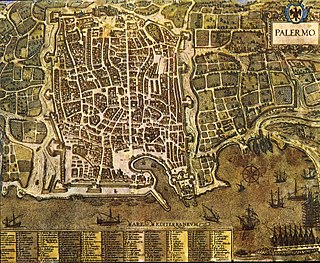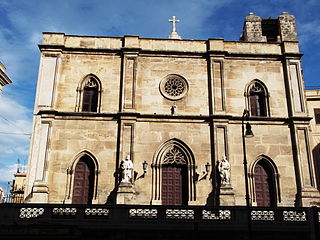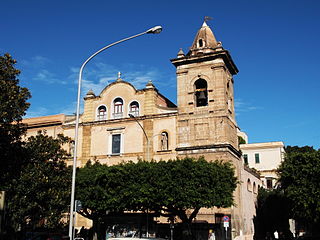
Palermo is a city in southern Italy, the capital of both the autonomous region of Sicily and the Metropolitan City of Palermo, the city's surrounding metropolitan province. The city is noted for its history, culture, architecture and gastronomy, playing an important role throughout much of its existence; it is over 2,700 years old. Palermo is in the northwest of the island of Sicily, by the Gulf of Palermo in the Tyrrhenian Sea.

Alcamo is the fourth-largest town and commune of the Province of Trapani, Sicily, with a population of 44.925 inhabitants. It is on the borderline with the Metropolitan City of Palermo at a distance of about 50 kilometres from Palermo and Trapani.

Lecce is a city in southern Italy and capital of the province of Lecce, with the second-highest population in the Apulia region. It is on the Salentine Peninsula, at the heel of the Italian Peninsula, and is over two thousand years old.

The Via del Corso is a main street in the historical centre of Rome. It is straight in an area otherwise characterized by narrow meandering alleys and small piazzas. Considered a wide street in ancient times, the Corso is approximately 10 metres wide, and it only has room for two lanes of traffic and two narrow sidewalks. The northern portion of the street is a pedestrian area. The length of the street is roughly 1.5 kilometres.

Palazzo Ajutamicristo is a Late-Gothic and Renaissance-style aristocratic palace located on VIa Garibaldi #23 of the ancient Kalsa quarter of Palermo, region of Sicily, Italy. It rises about a block south of Piazza Rivoluzione.
Quattro Canti, officially known as Piazza Vigliena, is a Baroque square in Palermo, region of Sicily, Italy; it is considered the center of the historic quarters of the city. The site is the intersection of two major streets in Palermo, the Via Maqueda and the Corso Vittorio Emanuele, and at this intersection are the corners of all four of the ancient quarters of Palermo: the Kalsa (SE); Seralcadi (SW); Albergaria (wW); and Castellammare (NE). On the southwest corner stands the church of San Giuseppe dei Padre Teatini. A few steps away along the flank of this church, behind the Southeast corner building, along Via Maqueda is the Piazza and Fontana Pretoria, sandwiched between this church and Santa Caterina. A few more steps reaches San Cataldo and the ancient Norman church of La Martorana. About 500 meters west along the Cassaro is the piazza of the Cathedral of Palermo and the adjacent Palazzo Normani.

Turin is a city and an important business and cultural centre in Northern Italy. It is the capital city of Piedmont and of the Metropolitan City of Turin, and was the first Italian capital from 1861 to 1865. The city is mainly on the western bank of the Po River, below its Susa Valley, and is surrounded by the western Alpine arch and Superga hill. The population of the city proper is 847,287, while the population of the urban area is estimated by Eurostat to be 1.7 million inhabitants. The Turin metropolitan area is estimated by the OECD to have a population of 2.2 million.
The city Milan, Italy, has had three different systems of defending walls. The oldest, Roman walls were developed in two stages, the first in the Republican and the second in the Imperial era. The second wall system was realized in the Middle Ages, after the destruction of the city by Frederick I Barbarossa. Finally, the latest wall system was built by the Spanish rulers. While very little remains of these walls, their structure is clearly reflected in the urbanistic layout of the city. In particular, modern Milan has two roughly circular rings of streets, namely the "Cerchia dei Navigli" and the "Cerchia dei Bastioni", which essentially correspond to the Medieval and Spanish walls, respectively. Note that a third ring of roads just beyond the Inner Ring Road, called the External Ring Road, does not owe itself to any old city walls; but was part of the 1884 Beruto Plan for the city of Milan, created and named after a municipal engineer and public servant to the local city government.

The Church of Saint Francis of Assisi is a Gothic-style, Roman Catholic church of Palermo. It is located near a major and ancient street of the city, via Cassaro, in the quarter of the Kalsa, within the historic centre of Palermo. The building represents the main Conventual Franciscan church of Sicily, and has the title of minor basilica.

Porta Felice is a monumental city gate of Palermo, Sicily; the gate is located in the zone of the Foro Italico and the Castellammare quarter. It represents the water-side entrance into what was formerly known as Via Cassaro, the most ancient main street of the city, but renamed Via Vittorio Emanuele after Italian unification. The gate was built in Renaissance and Baroque styles between the 16th and 17th centuries.

The Cassaro is the most ancient street of Palermo. From the late 16th century the street also had the name Via Toledo. Following the unification of Italy, it was officially renamed Via Vittorio Emanuele II, but the old and distinctive name is still in use. The street is rooted in the age of the foundation of Palermo by the Phoenicians. It provides access to a number of important sights, including the Royal Palace and the Cathedral, two UNESCO World Heritage Sites.

Via Maqueda, also known as "Strada Nuova", is an important street of Palermo. Together with the Cassaro, it represents the main axis of the historic centre and provides access to a number of important sights, including Teatro Massimo and Fontana Pretoria. The street is named after the Viceroy of Sicily Bernardino de Cárdenas y Portugal, Duque de Maqueda.

The Church of Saint Matthew is a Baroque-style, Roman Catholic church of Palermo, region of Sicily, Italy. It is located in the main street of the city, the ancient Cassaro now Corso Vittorio Emanuele, in the quarter of the Loggia, about a block east of the Quattro Canti, within the historic centre of Palermo.

The Garraffo Fountain is a Baroque fountain of Palermo. It is located in Piazza Marina, down the ancient Cassaro street, now called Via Vittorio Emanuele, within the historic centre of Palermo.

The following outline is provided as an overview of and topical guide to Palermo:

Sant'Antonio Abate is a Gothic-style Roman Catholic parish church located on Via Roma #203A in the ancient quarter of Castellammare, in central Palermo, region of Sicily, Italy. The church sits at the west corner of the Vucciria market.

The Palazzo Butera is a Baroque-style aristocratic palace located facing the Mediterranean in the ancient quarter of Kalsa of central Palermo, region of Sicily, Italy. On the shoreside, the long facade has a wide terrace, built atop the base of the former walls and called Passeggiata delle Cattive, in front of this is the park Foro Italico, in front, rising just south of Porta Felice and Via Vittorio Emanuele ; the access to the palace is from the land-side street of Via Butera.

The Palazzo Forcella de Seta is an eclectic-style aristocratic palace located facing the Mediterranean in the ancient quarter of Kalsa of central Palermo, region of Sicily, Italy. The palace was built atop the base of the former defensive walls of the city, including the Vega bastion and in its center, an original city gate, Porta dei Greci (1553) through which via Romano Giuseppe runs through. Some refer to the entire structure as the gate. To the seaside, stretches part of the park Foro Italico. In front of the Northeast corner, in front of the seaside facade, is the Monument to Vincenzo Florio Sr..

Madonna dei Rimedi is a Baroque-style, Roman Catholic Sanctuary-church, established and still affiliated with the Discalced Carmelite order, located on Piazza Indipendenza # 9, in Palermo, region of Sicily, Italy.

San Francesco di Paola is a 16th-century Roman Catholic church and monastery, located on Via Carini corner Piazza San Francesco di Paola, in Palermo, region of Sicily, Italy.




















